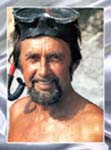Underwater Pioneer Hans Hass
A Fish Among Fish *
Hans Hass
Hans Hass, the Viennese pioneer of diving and marine biology celebrated on January 1, 2004 his 85th birthday. Born January 23, 1919 in Vienna as the son of a lawyer, he first encountered the underwater world as an eighteen-year-old in July 1937 during holidays to the south of France. From that day forth, his life was sealed.
From the time of his youth he was fascinated by the unknown and mysterious, including the ocean, not only shrouded in mystery but dangerous. In the 1930s, much less was known about the ocean. There were still rumors about sea snakes, dreadful sharks and other monsters of the ocean. Hans Hass entered the ocean armed with diving goggles and a spear and found a fairytale world that wouldn’t let him go. His friends in Vienna whom he told about his experiences wouldn’t believe him. So in 1938 he made his first underwater camera to document his adventures. This was the beginning of underwater photography. He, being a fish among fish, experienced things no one else had seen before because research scientists were too afraid to explore the reefs.
At first a sporting daredevil, he soon turned to serious scientific work. Already in 1941 he developed the first underwater diving equipment facilitating free movement on the ocean floor for longer periods of time. His pioneering inventions make him the actual founder of underwater diving, a sport practiced by millions today.
But his actual aim went further: The almost shocking idea of encouraging scientists, (mostly older, honorable gentlemen at the time), to shark-contaminated areas and that with proper equipment, one could bring valuable, new scientific discoveries.
From Vienna he moved to Berlin in the early 40s. He gave over one hundred lectures, introducing the new research method and collecting enough money to equip a research vessel. In 1942, only 23 years old, he bought a sea vessel but in the confusion of the last years of war, the ship was lost and like millions of others, he was faced with a devaluated bank account and almost all of his equipment was lost. In 1943 he earned his Ph.D. in Zoology from the University of Berlin.
With an unshakable faith in his dreams and despite all unfavorable circumstances, he achieved what no one could believe: By his own efforts he bought a ship, equipped it, and went on two long expeditions in the Pacific- and Indian Oceans. The scientific results of those trips went down in history and made Hans Hass famous. From that time forth, he shot innumerable films, wrote books, gave lectures, winning many awards for his underwater photography. One can hardly find any comparison to his planning and financing his expeditions entirely on his own. Scientific expeditions of this magnitude, - for example, the expeditions of Cousteau, - were usually supported by the government. Here was an example of what a single, dedicated person could achieve.
The inner restlessness of the research scientist and his urge for knowledge did not allow Hans Hass to rest on his laurels. He went off to new challenges, researching growth and development laws of biological organizations. Impartially, like he used to observe fish and their behavior in coral reefs, he now tried to study people. Systems and evolution research became his main focus for the next ten years. He left ocean caves for the university library in Vienna where he studies various kinds of economics. In 1970 he introduced his "Energon Theory" which contends that organisms live off positive energy balance. They have to be efficient to survive. This applies to coral fish and humans as well as businesses. In the following years he extended his theory, applying the results of his evolutionary research to the social behavior of humans, making it usable for businesses. Business found his thoughts interesting and he became a highly demanded consultant. In 1999 he founded the International Hans Hass Institute for Energon-Cybernetic Research, within the Department. of Theoretical Science and Research at the University of Vienna, incorporating multidisciplinary fields.
His has an exceptionally versatile and interesting life - the work of the tireless laborer and passionate researcher. He is a man whose life has not been completed yet and who is still going on expeditions to unknown places - further, interdisciplinary projects - and that at the age of 85.
*Excerpts taken from: Hans Hass by Michael Jung, 1994; Merzig.
For more information, see his homepage: www.hans-hass.de
